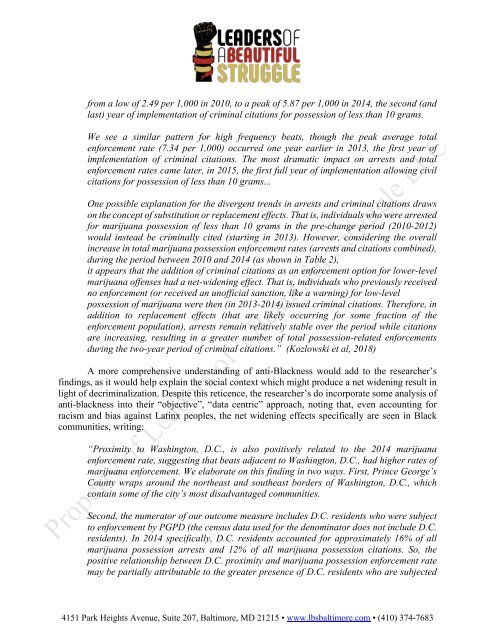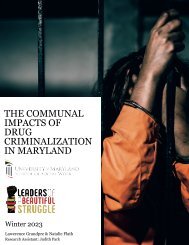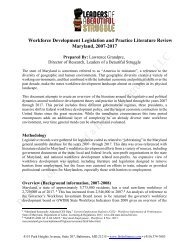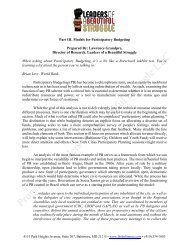Drug Decriminalization in Maryland Through an African Centered Research Paradigm- Analysis and Recommendations
This document offers guidance for theorizing questions related to a proposed research project purposed to advance drug decriminalization in Maryland.
This document offers guidance for theorizing questions related to a proposed research project purposed to advance drug decriminalization in Maryland.
- No tags were found...
Create successful ePaper yourself
Turn your PDF publications into a flip-book with our unique Google optimized e-Paper software.
from a low of 2.49 per 1,000 <strong>in</strong> 2010, to a peak of 5.87 per 1,000 <strong>in</strong> 2014, the second (<strong>an</strong>d<br />
last) year of implementation of crim<strong>in</strong>al citations for possession of less th<strong>an</strong> 10 grams.<br />
We see a similar pattern for high frequency beats, though the peak average total<br />
enforcement rate (7.34 per 1,000) occurred one year earlier <strong>in</strong> 2013, the first year of<br />
implementation of crim<strong>in</strong>al citations. The most dramatic impact on arrests <strong>an</strong>d total<br />
enforcement rates came later, <strong>in</strong> 2015, the first full year of implementation allow<strong>in</strong>g civil<br />
citations for possession of less th<strong>an</strong> 10 grams...<br />
One possible expl<strong>an</strong>ation for the divergent trends <strong>in</strong> arrests <strong>an</strong>d crim<strong>in</strong>al citations draws<br />
on the concept of substitution or replacement effects. That is, <strong>in</strong>dividuals who were arrested<br />
for mariju<strong>an</strong>a possession of less th<strong>an</strong> 10 grams <strong>in</strong> the pre-ch<strong>an</strong>ge period (2010-2012)<br />
would <strong>in</strong>stead be crim<strong>in</strong>ally cited (start<strong>in</strong>g <strong>in</strong> 2013). However, consider<strong>in</strong>g the overall<br />
<strong>in</strong>crease <strong>in</strong> total mariju<strong>an</strong>a possession enforcement rates (arrests <strong>an</strong>d citations comb<strong>in</strong>ed),<br />
dur<strong>in</strong>g the period between 2010 <strong>an</strong>d 2014 (as shown <strong>in</strong> Table 2),<br />
it appears that the addition of crim<strong>in</strong>al citations as <strong>an</strong> enforcement option for lower-level<br />
mariju<strong>an</strong>a offenses had a net-widen<strong>in</strong>g effect. That is, <strong>in</strong>dividuals who previously received<br />
no enforcement (or received <strong>an</strong> unofficial s<strong>an</strong>ction, like a warn<strong>in</strong>g) for low-level<br />
possession of mariju<strong>an</strong>a were then (<strong>in</strong> 2013-2014) issued crim<strong>in</strong>al citations. Therefore, <strong>in</strong><br />
addition to replacement effects (that are likely occurr<strong>in</strong>g for some fraction of the<br />
enforcement population), arrests rema<strong>in</strong> relatively stable over the period while citations<br />
are <strong>in</strong>creas<strong>in</strong>g, result<strong>in</strong>g <strong>in</strong> a greater number of total possession-related enforcements<br />
dur<strong>in</strong>g the two-year period of crim<strong>in</strong>al citations.” (Kozlowski et al, 2018)<br />
A more comprehensive underst<strong>an</strong>d<strong>in</strong>g of <strong>an</strong>ti-Blackness would add to the researcher’s<br />
f<strong>in</strong>d<strong>in</strong>gs, as it would help expla<strong>in</strong> the social context which might produce a net widen<strong>in</strong>g result <strong>in</strong><br />
light of decrim<strong>in</strong>alization. Despite this reticence, the researcher’s do <strong>in</strong>corporate some <strong>an</strong>alysis of<br />
<strong>an</strong>ti-blackness <strong>in</strong>to their “objective”, “data centric” approach, not<strong>in</strong>g that, even account<strong>in</strong>g for<br />
racism <strong>an</strong>d bias aga<strong>in</strong>st Lat<strong>in</strong>x peoples, the net widen<strong>in</strong>g effects specifically are seen <strong>in</strong> Black<br />
communities, writ<strong>in</strong>g:<br />
“Proximity to Wash<strong>in</strong>gton, D.C., is also positively related to the 2014 mariju<strong>an</strong>a<br />
enforcement rate, suggest<strong>in</strong>g that beats adjacent to Wash<strong>in</strong>gton, D.C., had higher rates of<br />
mariju<strong>an</strong>a enforcement. We elaborate on this f<strong>in</strong>d<strong>in</strong>g <strong>in</strong> two ways. First, Pr<strong>in</strong>ce George’s<br />
County wraps around the northeast <strong>an</strong>d southeast borders of Wash<strong>in</strong>gton, D.C., which<br />
conta<strong>in</strong> some of the city’s most disadv<strong>an</strong>taged communities.<br />
Second, the numerator of our outcome measure <strong>in</strong>cludes D.C. residents who were subject<br />
to enforcement by PGPD (the census data used for the denom<strong>in</strong>ator does not <strong>in</strong>clude D.C.<br />
residents). In 2014 specifically, D.C. residents accounted for approximately 16% of all<br />
mariju<strong>an</strong>a possession arrests <strong>an</strong>d 12% of all mariju<strong>an</strong>a possession citations. So, the<br />
positive relationship between D.C. proximity <strong>an</strong>d mariju<strong>an</strong>a possession enforcement rate<br />
may be partially attributable to the greater presence of D.C. residents who are subjected<br />
4151 Park Heights Avenue, Suite 207, Baltimore, MD 21215 • www.lbsbaltimore.com • (410) 374-7683









